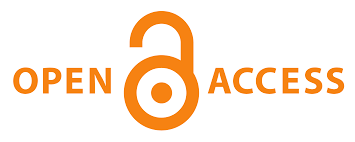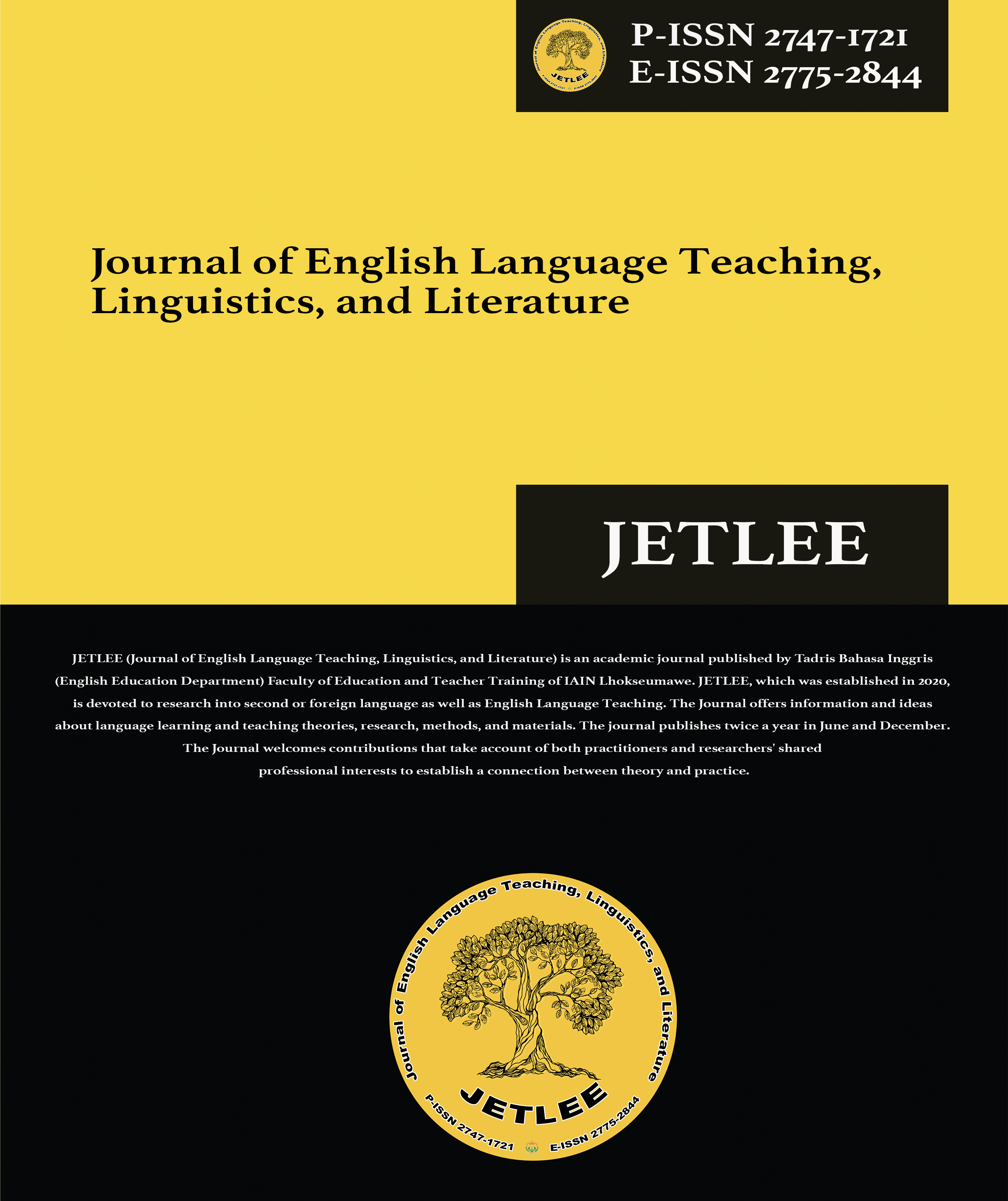Identifying Factors Contributing to Students’ Obstacles in Comprehending Recount Text
Main Article Content
Samhudi Samhudi
This research was conducted to find out the difficulties faced by students in understanding recount text, and the factors that cause these difficulties. To obtain data in this study, the researcher used two data collection techniques, namely observation and interview. Observation is used to collect data in class during the teaching learning process. Interview is intended to identify the causes of the students’ obstacles in understanding recount text. There were 6 students at eleventh grade of SMAN 1 Nisam who were used as subjects in this research. 2 students who have high academic achievement, 2 medium and 2 low. The result showed that they had many difficulties in understanding recount text, both internal and external factors. The internal factor is the lack of motivation. Besides, they also have difficulties in understanding the sentence structure in recount text. In addition, they also lack of vocabulary mastery, it makes them difficult and take a long time to understand a text in English. The external factors that cause their difficulties in understanding English texts are the lack of attention from their parents towards their achievement, especially towards English achievement. They also only have a little time to learn and practice English at their home because they are busy with other activities. The lack of supporting facilities such as English reading materials and dictionaries, it is also one of the factors causing students’ difficulties in understanding recount text.
Adams, M. J. (2017). Failures to comprehend and levels of processing in reading. In Theoretical issues in reading comprehension (pp. 11-32). Routledge. DOI: https://doi.org/10.4324/9781315107493
Afflerbach, P., Pearson, P. D., & Paris, S. G. (2008). Clarifying differences between reading skills and reading strategies. The reading teacher, 61(5), 364-373. DOI: https://doi.org/10.1598/RT.61.5.1
Caravolas, M., Lervåg, A., Mikulajová, M., Defior, S., Seidlová-Málková, G., & Hulme, C. (2019). A cross-linguistic, longitudinal study of the foundations of decoding and reading comprehension ability. Scientific Studies of Reading, 23(5), 386-402. Doi: https://doi.org/10.1080/10888438.2019.1580284
Carver, J., Shull, F., & Basili, V. (2003). Observational studies to accelerate process experience in classroom studies: An evaluation. In 2003 International Symposium on Empirical Software Engineering, 2003. ISESE 2003. Proceedings. (pp. 72-79). IEEE. DOI: 10.1109/ISESE.2003.1237966
Cornoldi, C., & Oakhill, J. V. (Eds.). (2013). Reading comprehension difficulties: Processes and intervention. Routledge.
Dubiner, D. (2017). Using vocabulary notebooks for vocabulary acquisition and teaching. Elt Journal, 71(4), 456-466. DOI: https://doi.org/10.1093/elt/ccx008
Eason, S. H., Goldberg, L. F., Young, K. M., Geist, M. C., & Cutting, L. E. (2012). Reader–text interactions: How differential text and question types influence cognitive skills needed for reading comprehension. Journal of educational psychology, 104(3), 515. DOI: https://doi.org/10.1037/a0027182
Elsjelyn, E. R. (2014). English Made Easy: Kunci Sukses Belajar Bahasa Inggris. Kesaint Blanc.
Galletta, A. (2013). Mastering the semi-structured interview and beyond: From research design to analysis and publication (Vol. 18). NYU press.
Hedgcock, J. S., & Ferris, D. R. (2018). Teaching readers of English: Students, texts, and contexts. Routledge.
Hjetland, H. N., Brinchmann, E. I., Scherer, R., Hulme, C., & Melby-Lervåg, M. (2020). Preschool pathways to reading comprehension: A systematic meta-analytic review. Educational Research Review, 30, 100323. DOI: https://doi.org/10.1016/j.edurev.2020.100323
Tarigan, N. W. P. (2021). AN ANALYSIS OF STUDENTS’COMPREHENSION IN IDENTIFYING FACT AND OPINION IN PARAGRAPH. Journal of English Teaching, Linguistics, and Literature, 1(2), 100-121.
Munanda, A., Bewa, I., & Barus, J. (2020). THE IMPLEMENTATION OF USING CODING TEXT STRATEGY IN TEACHING READING COMPREHENSION. Journal of English Teaching, Linguistics, and Literature, 1(1), 77-89.
Israwati, I., & Erlidawati, E. (2020). AN ANALYSIS OF STUDENTS’ERRORS IN USING QUANTIFIER ON RECOUNT TEXT. Journal of English Teaching, Linguistics, and Literature, 1(1), 1-12.
Hyland, K. (2013). Materials for developing writing skills. Developing materials for language teaching, 391-405.
Kintsch, W., & Kintsch, E. (2005). Comprehension. In Children's reading comprehension and assessment (pp. 89-110). Routledge.
Perfetti, C. A., Landi, N., & Oakhill, J. (2005). The acquisition of reading comprehension skill. In M. J. Snowling & C. Hulme (Eds.), The science of reading: A handbook (pp. 227–247). Blackwell Publishing. DOI: https://doi.org/10.1002/9780470757642.ch13
Rahman, F., & Saputra, N. (2021). English as International Language Revisited: Implications on South Korea’s ELT Context. Scope: Journal of English Language Teaching, 6(1), 08-15. DOI: http://dx.doi.org/10.30998/scope.v6i1.9383
Sadeghi, M., & Izadpanah, S. (2018). Barriers in teaching reading to ELLs and ways of overcoming those obstacles. Journal of Language Teaching and Research, 9(2), 295-301. DOI: http://dx.doi.org/10.17507/jltr.0902.10
Schallert, D. L. (2017). The role of illustrations in reading comprehension. Theoretical issues in reading comprehension, 503-524.
Smith, N. B. (1969). The many faces of reading comprehension. The Reading Teacher, 23(3), 249-291.
Smith, R., Snow, P., Serry, T., & Hammond, L. (2021). The role of background knowledge in reading comprehension: A critical review. Reading Psychology, 42(3), 214-240. DOI: https://doi.org/10.1080/02702711.2021.1888348
Wei, L. (2022). Translanguaging as a political stance: Implications for English language education. ELT journal, 76(2), 172-182. DOI: https://doi.org/10.1093/elt/ccab083
Yuzar, E., & Rahmiaty, F. R. (2022). “Am I being Rude”: Exploring Indonesian Students’intercultural Communicative Competence In Inner Circle Countries. Lingual: Journal of Language and Culture, 13(1), 18-27. DOI: https://doi.org/10.24843/LJLC.2022.v13.i01.p02




